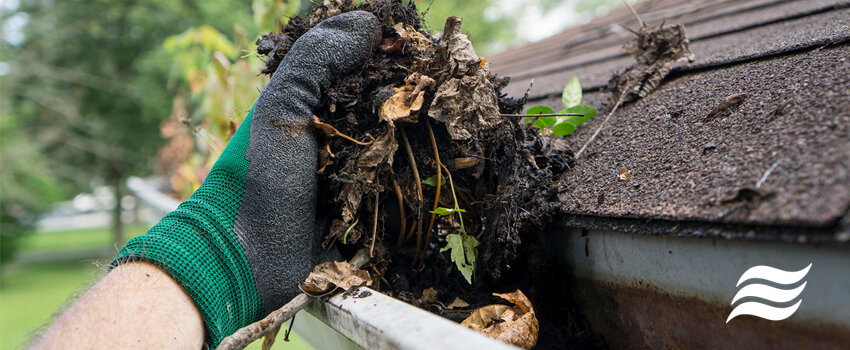
Spring is here! Time to clean out your gutters and get ready for summer
Spring has sprung and that means we're all going to be outside enjoying the weather! Before getting to enjoy that though, the new season brings a new list of maintenance must-dos with it. You don't want to spring a leak during a family BBQ!
In this month's blog post, we're going to look at the most essential spring plumbing maintenance tasks.
1. Clean out your gutters, drains, and downspouts
When the sun starts to shine, it's time to get rid of the buildup of debris in your property's drains and gutters. During the harsh weather of winter dead leaves, sticks and other unpleasant things clog up your outdoor pipework. After spring, you might find birds, bugs or little critters have made their nests in your gutters too.
By removing any debris that's stuck in your guttering, you're going to avoid plumbing problems in the future. If rainwater can't run freely down your drains, it's going to pool behind the clog and overrun. When left to overflow, your home can end up with a serious damp problem.
The best thing to do is give your guttering and drains a thorough clean out before summer kicks in.
2. Drain your water heater
One of the most important things you can do for your water heater is to drain it, at least twice a year.
The reason? Sediment and mineral deposits build up over time at the bottom of your heater tank. Over time, this can cause corrosion and significantly shorten your heater life span. In the short term, sediment in your water tank will seriously reduce the efficiency of the unit.
The best way to avoid all of that is to drain the tank. There should be a release valve at the bottom of your water heater tank – just make sure to be ready to dispose of all that excess water properly.
A little pro tip: while you’re already at the water heater, it's a great chance to check the water heater temperature setting. To avoid scalding water but still enjoy a hot shower and be able to wash the dishes properly, it's recommended to set the temperature to 120 degrees F. If it's currently set higher, this switch will also save on your energy bill too!
3. Check your outdoor faucets for damage
It's a good choice to check all of your faucets for leaks or damage caused over the frosty winter – but if you're planning on using an outdoor faucet, it's even more important to do so.
When you turn on the faucet for the first time after winter, you need to make sure there hasn't been any cracks or holes created due to plummeting temperatures.
There's a couple of things you can do to check for any problems. If you have a basement, head down there and check any exposed pipework for visible signs of damage.
Next, if you have a hose, attach that, then turn on the faucet. If you have a hose, kink the hose. If you can still hear water running, you know you have a problem. This means it's running inside your wall and this can cause a lot of damage incredibly quickly. Turn of the faucet and don't use it again until you've had a professional look at it.
Don't use a hose? Turn the outdoor faucet on – if it only drips (rather than flowing normally), you may have a cracked pipe on your hands.
In both of these scenarios, you’ll need the help of a seasoned plumber – give us a call.
4. Make sure your toilets are in top working condition
Summer means more entertaining at home, more guests over and well, your toilets have more work to do. The last thing you need during a family get-together is a broken toilet!
To check for hidden leaks, there's a super easy test you can do yourself. Open up your toilet's top tank and pop a few drops of food dye into the water. Check on the color of the bowl water every 10 minutes. If the dye has traveled down to the toilet bowl within 30 minutes-ish, you've got a leak somewhere.
Figuring out what's leaking and where is the difficult part. Sometimes an old seal might need replacing, sometimes it can be a sign of a bigger issue. It's best to get any leaks sorted out as soon as possible – a small leak in your toilet can cause your water bill to skyrocket in a very short amount of time.
5. Turn your water supply valves off and on
This is a quick and easy maintenance task that is often overlooked.
On all of your toilets and sinks, there are water supply valves that can be turned to control the flow of water to each item. Plumbers (or for those of you keen on DIY) use these to turn off the water supply to a unit they're repairing. This stops them having to turn off the water supply for the whole house.
The problem is, they're often forgotten about until they're needed! If they're left in one position for a lengthy amount of time, they can get too stiff to turn. To prevent this (and make your plumber's job a lot easier), you can turn them a few times towards the “off” position and then back on so they don’t get stuck.
By implementing these super simple spring plumbing maintenance tasks, you'll keep your plumbing system in top form for the summer ahead.